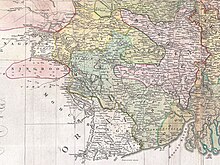Singhbhum district
| Singhbhum District | |||||||||
|---|---|---|---|---|---|---|---|---|---|
| District of the Bengal Presidency | |||||||||
| 1820–1947 | |||||||||
|
Flag | |||||||||
 Singhbhum district in a 1909 map of The Imperial Gazetteer of India | |||||||||
| Capital | Chaibasa | ||||||||
| Area | |||||||||
• 1901 | 10,078 km2 (3,891 sq mi) | ||||||||
| Population | |||||||||
• 1872 | 318,180 | ||||||||
• 1881 | 453,775 | ||||||||
• 1891 | 545,488 | ||||||||
• 1901 | 613,579 | ||||||||
• 1931 | 929,802 | ||||||||
| History | |||||||||
• The Raja of Singhbhum becomes a feudatory of the British | 1820 | ||||||||
• Accession to the Union of India as district of Bihar | 1947 | ||||||||
• Bifurcation | 1990 | ||||||||
| |||||||||
Singhbhum was a district of India during the
Etymology
Singhbhum is a
Geography
It is bounded with
History
The Singhbhum area was never invaded by either the


Following the
Demographics
| Year | Pop. | ±% |
|---|---|---|
| 1901 | 754,658 | — |
| 1911 | 843,040 | +11.7% |
| 1921 | 911,935 | +8.2% |
| 1931 | 1,116,424 | +22.4% |
| 1941 | 1,350,141 | +20.9% |
| 1951 | 1,480,816 | +9.7% |
| 1961 | — | |
| 1971 | 2,437,799 | — |
| 1981 | — | |
| Post the 1981 census, the district bifurcated into East and West Singhbhum districts. Note: The census data exhibit discrepancies owing to changes in administration within specific regions of Singhbhum. Source: Census of India[6] | ||
According to the 1931 census, the total population of Singhbhum (including Dhalbhum) was 929,802. The predominant communities in the region were the Ho, comprising 32.39% of the population, followed by the Santal at 11.71%, Bhumij at 5.71%, Munda at 5.48%, Gaura at 5.04%, Tanti at 4.09%, Goala at 3.79%, Hajjam at 2.68%, Kurmi at 2.42%, Bhuiyan at 1.97%, Kamar at 1.87%, Brahman at 1.71%, Kumhar at 1.49%, Rajput at 1.4%, Teli at 1.31%, Oraon at 1.09%, Kayastha at 1.04%, and others such as Kewat, Gadaba, Dhobi, Kharia, Bania, Dom, Mahli, Chamar, Khandait, Hari, Kahar, Jolaha, Mallah, Karmali, Bathudi, Karan, Savar, Korwa, Mochi, and Birhor.[7]
In terms of language, the Ho language was the most prevalent at 32.83%, followed by Odia at 18.49%, Bengali at 15.87%, Santali at 11.15%, Hindi and Urdu at 8.72%, Mundari at 5.85%, Bhumij at 3.25%, and other notable spoken languages such as Telugu, Panjabi, Tamil, Mahli, Gujurati, Nepali, Gondi, Marwari,
References
- ^ Chisholm, Hugh, ed. (1911). . Encyclopædia Britannica. Vol. 25 (11th ed.). Cambridge University Press. p. 148.
- ^ a b c "Imperial Gazetteer2 of India, Volume 23, page 1 -- Imperial Gazetteer of India -- Digital South Asia Library". dsal.uchicago.edu. Retrieved 28 October 2022.
- ISBN 978-3-11-054085-7.
- ^ Journal of Historical Research. Department of History, Ranchi University. 2003.
- ^ Wilson Hunter, Sir William; Sutherland Cotton, James; Sir Richard Burn, Sir William Stevenson Meyer. Great Britain India Office. The Imperial Gazetteer of India. Oxford: Clarendon Press, 1908
- ^ Prasad, Ranchar (1956). District Census Handbook Singhbhum - Census 1951 (PDF). Director of Census Operations, Bihar. pp. 3, 22.
- ^ a b c Lacey, W. G. (1932). Census of India, 1931 (PDF). Vol. VII. Bihar and Orissa (Part. II. Tables). Superintendent, Government Printing. see. Table XVII & XVIII.
Bibliography
- O'Malley, L. S. S. (1910). Bengal district gazetteers : Singhbhum, Saraikela and Kharsawan. Calcutta: Bengal Secretariat Book Depot. OCLC 220796364. Archived from the originalon 18 January 2017.
- Roy Choudhary, P.C. (1958). Bihar District Gazetteers: Singhbhum. Patna, Superintendent Secretariat Press.

